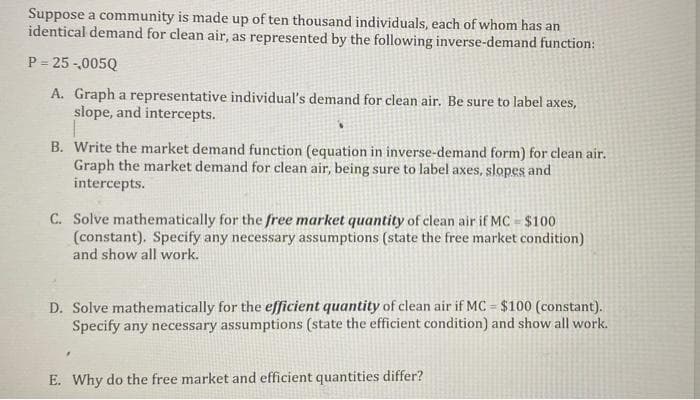Suppose a community is made up of ten thousand individuals, each of whom has an identical demand for clean air, as represented by the following inverse-demand function: P= 25 -,005Q A. Graph a representative individual's demand for clean air. Be sure to label axes, slope, and intercepts. B. Write the market demand function (equation in inverse-demand form) for clean air. Graph the market demand for clean air, being sure to label axes, slopes and intercepts. C. Solve mathematically for the free market quantity of clean air if MC - $100 (constant). Specify any necessary assumptions (state the free market condition) and show all work. D. Solve mathematically for the efficient quantity of clean air if MC = $100 (constant). Specify any necessary assumptions (state the efficient condition) and show all work. E. Why do the free market and efficient quantities differ?
Suppose a community is made up of ten thousand individuals, each of whom has an identical demand for clean air, as represented by the following inverse-demand function: P= 25 -,005Q A. Graph a representative individual's demand for clean air. Be sure to label axes, slope, and intercepts. B. Write the market demand function (equation in inverse-demand form) for clean air. Graph the market demand for clean air, being sure to label axes, slopes and intercepts. C. Solve mathematically for the free market quantity of clean air if MC - $100 (constant). Specify any necessary assumptions (state the free market condition) and show all work. D. Solve mathematically for the efficient quantity of clean air if MC = $100 (constant). Specify any necessary assumptions (state the efficient condition) and show all work. E. Why do the free market and efficient quantities differ?
Principles of Economics, 7th Edition (MindTap Course List)
7th Edition
ISBN:9781285165875
Author:N. Gregory Mankiw
Publisher:N. Gregory Mankiw
Chapter11: Public Goods And Common Resources
Section: Chapter Questions
Problem 2PA
Related questions
Question
Ñ6

Transcribed Image Text:Suppose a community is made up of ten thousand individuals, each of whom has an
identical demand for clean air, as represented by the following inverse-demand function:
P = 25 -,005Q
A. Graph a representative individual's demand for clean air. Be sure to label axes,
slope, and intercepts.
B. Write the market demand function (equation in inverse-demand form) for clean air.
Graph the market demand for clean air, being sure to label axes, slopes and
intercepts.
C. Solve mathematically for the free market quantity of clean air if MC = $100
(constant). Specify any necessary assumptions (state the free market condition)
and show all work.
D. Solve mathematically for the efficient quantity of clean air if MC = $100 (constant).
Specify any necessary assumptions (state the efficient condition) and show all work.
E. Why do the free market and efficient quantities differ?
Expert Solution
This question has been solved!
Explore an expertly crafted, step-by-step solution for a thorough understanding of key concepts.
Step by step
Solved in 2 steps with 7 images

Recommended textbooks for you

Principles of Economics, 7th Edition (MindTap Cou…
Economics
ISBN:
9781285165875
Author:
N. Gregory Mankiw
Publisher:
Cengage Learning

Essentials of Economics (MindTap Course List)
Economics
ISBN:
9781337091992
Author:
N. Gregory Mankiw
Publisher:
Cengage Learning

Principles of Economics (MindTap Course List)
Economics
ISBN:
9781305585126
Author:
N. Gregory Mankiw
Publisher:
Cengage Learning

Principles of Economics, 7th Edition (MindTap Cou…
Economics
ISBN:
9781285165875
Author:
N. Gregory Mankiw
Publisher:
Cengage Learning

Essentials of Economics (MindTap Course List)
Economics
ISBN:
9781337091992
Author:
N. Gregory Mankiw
Publisher:
Cengage Learning

Principles of Economics (MindTap Course List)
Economics
ISBN:
9781305585126
Author:
N. Gregory Mankiw
Publisher:
Cengage Learning

Principles of Microeconomics (MindTap Course List)
Economics
ISBN:
9781305971493
Author:
N. Gregory Mankiw
Publisher:
Cengage Learning

